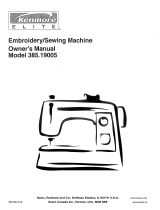
1
Name of parts ..............................................................2
Standard accessories .................................................. 3
GETTING READY TO SEW
Connecting the power supply....................................... 4
For your safety .............................................................4
Polarized plug...............................................................4
Start/stop button........................................................... 5
Presser foot lifter .......................................................... 5
Winding the bobbin ......................................................6
Removing the bobbin ............................................... 6
Setting the spool of thread....................................... 6
Additional spool pin.................................................. 6
Winding the bobbin .................................................. 7
Inserting the bobbin .................................................8
Threading the machine ................................................ 9
Needle threader ......................................................... 10
Drawing up the bobbin thread .................................... 11
Changing the needle .................................................. 12
Adjusting the thread tension....................................... 13
Balanced thread tension ........................................ 13
When the needle thread tension is too tight .......... 13
When the needle thread tension is too loose......... 13
Adhesive (iron-on) stabilizer....................................... 14
Stabilizers................................................................... 14
Types of stabilizer .................................................. 14
Usage .................................................................... 14
Template..................................................................... 14
KEY OPERATIONS...............................................15-21
Adjusting the brightness of LCD screen..................... 15
Function panel.......................................................15-16
Setting mode .............................................................. 17
Machine settings ...................................................17-20
HELP key ................................................................... 21
Setting the fabric in the embroidery hoop .................. 22
Attaching the embroidery hoop to the machine ......... 23
Selecting built-in designs ........................................... 24
Ready to sew screen.................................................. 24
Color list screen ......................................................... 24
Starting to sew embroidery ...................................25-26
When the upper thread has broken or run out while
sewing.................................................................... 26
Lettering embroidery .............................................27-30
Selecting fonts ....................................................... 27
Entering characters................................................ 27
To enter lettering .................................................... 28
Ready to sew screen ............................................. 29
Color change ......................................................... 29
Placement of lettering embroidery.........................29
Maximum number of characters ............................ 29
To view a long lettering .......................................... 30
Deleting a letter...................................................... 30
Inserting a letter.....................................................30
Editing mode ........................................................31- 38
Selecting the hoop ................................................. 31
Selecting the pattern to edit ...................................32
Magnifier key.......................................................... 33
Flipping the pattern ................................................ 33
Resizing the pattern...............................................34
Rotating the pattern ...............................................34
Combining patterns...........................................35-38
Saving the file............................................................. 39
Saving in internal memory ......................................... 39
Name of file ...........................................................39-40
Saving in USB memory (optional) ..............................41
Creating a new folder ................................................. 42
Opening a file from the internal memory.................... 43
Deleting a file ............................................................. 43
Opening a file from USB memory (optional) ..............44
CARE AND MAINTENANCE .....................................45
Cleaning the hook race ..............................................45
Assembling the hook race..........................................45
TROUBLESHOOTING ..........................................46-47
DESIGN CHARTS.................................................48-50
Table of contents




















